
views
With a Food Dehydrator

Cut or shred the cheese into small pieces. Blocks of cheese won’t dry all the way through, no matter what type you’re using, so you'll have to cut them up. First, pat the pieces with a paper towel to soak up any moisture. When the cheese is dry, shred it into small pieces with a cheese grater. If you don't have a cheese grater, then slice up the cheese into tiny cubes no more than about ⁄2 in (1.3 cm) on any side. You can also dry wet cheese like cottage or ricotta. Do your best to strain out as much liquid as possible with a fine strainer or cheesecloth.

Set your food dehydrator below 140 °F (60 °C). Set your dehydrator to its lowest heat setting, which is usually 125–135 °F (52–57 °C). This is ideal for slow-drying the cheese. Don't try to dry cheese at a higher temperature than 140 °F (60 °C) because it will just cook instead of drying out.

Spread the cheese out on the dehydrator tray. Try not to overlap the cheese so it all dries out evenly. If you run out of room, switch to the next dehydrator tray, since most dehydrators have several levels. If your dehydrator doesn’t have a sheet to absorb moisture, then line the tray with paper towels. The drying process creates a lot of grease and this could drip down onto lower layers in the dehydrator. If you’re drying a lot of cheese and run out of room, just save some in the refrigerator and dry it the following day.
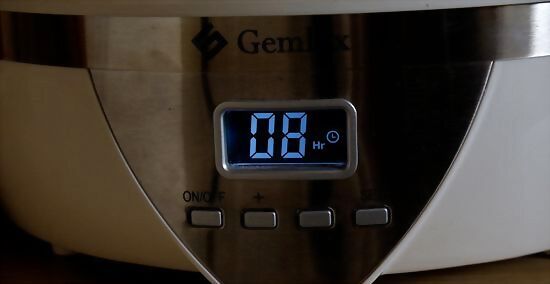
Dehydrate the cheese for 6-10 hours. Now all you have to do is wait. Leave the cheese in the dehydrator and let the heat do its work. Depending on the type of cheese, it’ll take 6-10 hours for it to dry completely. The time depends on how much water the type of cheese contains. Parmesan or hard provolone is already pretty dry, so the drying time will be around the 6-hour mark. Softer cheeses like mozzarella or brie need more time. Very wet cheeses like ricotta might even need up to 12 hours to dry. A good general rule is that the softer a cheese is, the more water it has. Use this as a guide if you aren’t sure how moist the cheese you’re using is.

Remove the cheese from the dehydrator when it’s dry and crunchy. Check on the cheese after a few hours. Pick some up and squeeze it. If the cheese is crunchy and hard, then it's ready to take out. If it’s still soft or a little mushy, then it needs more time.
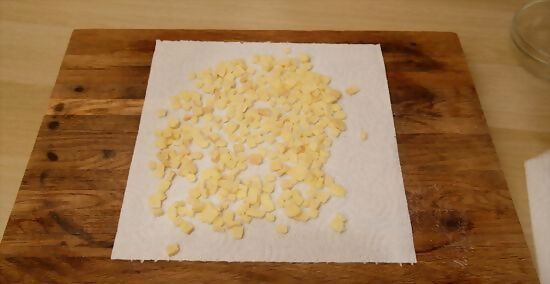
Arrange the cheese onto paper towels to soak up any excess grease. It’s normal for a bit of grease to build up on the outside of the cheese, especially if it was a wetter type. Just lay the cheese out on paper towels and pat it down with another towel to soak up all the moisture. Then you’re all set to enjoy your dried cheese! Dried cheese can last several years in the refrigerator in an airtight container. It might even last up to 10 years.
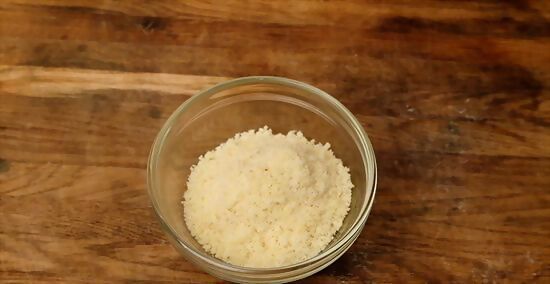
Grind the cheese in a coffee grinder to make powder. Powdering the cheese is very simple. Just sprinkle the dried pieces into a coffee grinder and grind them on a high setting until they make a fine powder. This is a great topping for pasta or snacks. Use a food processor if you don't have a coffee grinder. Store the powder in the refrigerator in an airtight container as well.
In the Microwave

Grate the cheese into small pieces. Bigger blocks of cheese won't dry out properly. Use a cheese grater and shred up the cheese that you're using so it dries all the way through. If you don't have a cheese grater, slice up the cheese with a knife. Try to get the pieces as small as shredded cheese from a grater. This recipe uses cheddar, but you could try it out with other cheeses too. Wet or soft cheeses like ricotta will work, but they'll probably need more time in the microwave.
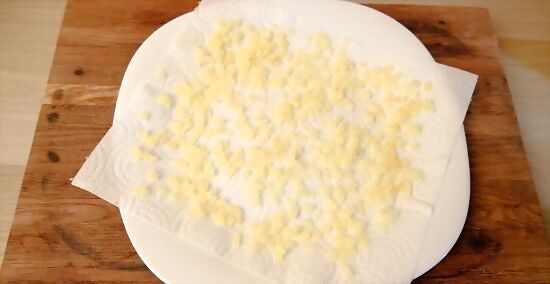
Spread the cheese on a microwave-safe tray. Put down parchment paper first. Then spread the cheese out evenly on the tray in a single layer. Don't overlap the cheese or it might not dry out as well.
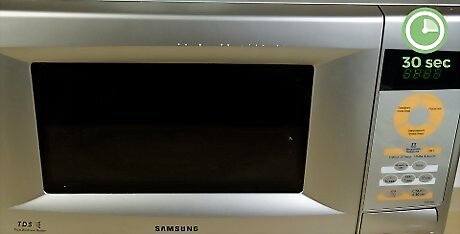
Microwave the cheese in 30-second intervals for 2 minutes. Put the tray into the microwave and turn it on for 30 seconds. The cheese should start melting. Continue pulsing the cheese in 30-second increments for 2 minutes to melt it and draw the fat out. You might need more time for a wet cheese. You'll know that the cheese is done when it reduces to a flat disc and the grease is all drawn out.

Place the cheese on a paper towel to harden. Take the tray out of the microwave and let the cheese cool down a bit. Then lay the cheese on a paper towel to soak up any grease. Don't worry if the cheese still feels soft when you take it out of the microwave. It'll harden as it cools.

Break the cheese into pieces or grind it into powder. If you'd like to make powdered cheese for a topping, then this is very easy. Break the cheese into smaller pieces and load it into a food processor. Then pulse the processor until the cheese breaks down into a powder. Add 1/4 tsp (4 g) of cornstarch and grind the powder one more time. Store the powdered cheese in an airtight container and refrigerate it for up to 2 weeks, You don't have to powder the cheese if you don't want to. You can keep the pieces intact too.
In the Oven
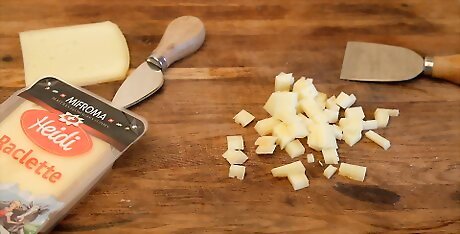
Cut or shred the cheese into small pieces. Blocks of cheese won’t dry all the way through, no matter what type you’re using. First, soak up any moisture by patting the cheese with a paper towel. When the cheese is dry, shred it into small pieces with a cheese grater. If you don't have a cheese grater, then slice up the cheese into tiny cubes no more than about ⁄2 in (1.3 cm) on any side. You can also use wet cheese like cottage or ricotta. Do your best to strain out as much liquid as possible with a fine strainer or cheesecloth.

Set your oven to 110–170 °F (43–77 °C). Food dehydrators can be expensive, so it’s understandable if you don’t want to buy one to dry out your cheese. Luckily, you can get a similar result in an oven. Start by setting your oven to a low heat, ideally between 110–170 °F (43–77 °C) if your oven can handle that, so the cheese will dehydrate slowly. The results won’t be quite as good as if you used a food dehydrator, but it will be pretty close. This trick doesn’t work with all ovens. The oven has to be able to work at temperatures below 200 °F (93 °C), and not all ovens can do that.
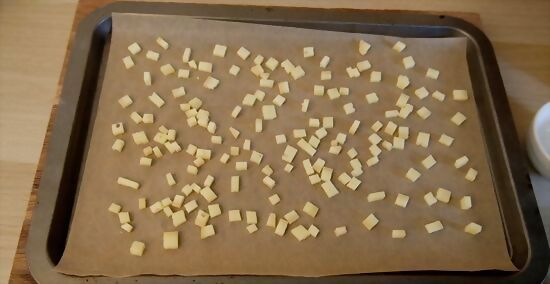
Arrange the cheese in a single layer on an oven-safe baking sheet. Spread the pieces of cheese out evenly and don’t overlap them. If pieces overlap, they won't dry out evenly. If you’re working with a wetter cheese, then put down parchment paper or paper towels to soak up the grease. It's safe to use paper towels in the oven at this temperature, but don't use them for higher temperatures or they could catch fire.

Bake the cheese for 8-12 hours. Just pop the pan in the oven and wait. The cheese will slow-dry over several hours, so leave the oven to do its work. It should take 8-12 hours for the cheese to dry out. Take it out when it looks crunchy and slightly brown. Like with a dehydrator, the baking time depends on what kind of cheese you were using. Dry cheeses will be on the lower end of that spectrum, and wet cheeses need more time. If the cheese looks very greasy, then take it out after 3-4 hours and wipe it down with paper towels to get rid of excess moisture.
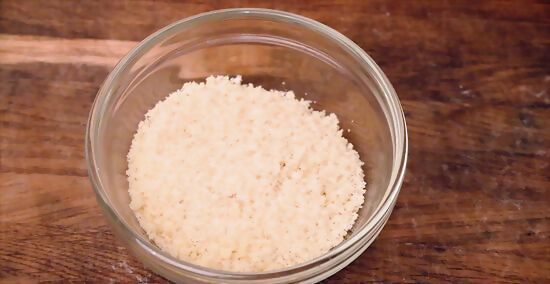
Break the cheese into pieces or grind it into a powder. If you want to powder the cheese, then just sprinkle the dried pieces into a coffee grinder. Grind them on a high setting until they make a fine powder. Use this as a tasty topping for pasta or snacks. Use a food processor if you don't have a coffee grinder. Store the powder in the refrigerator in an airtight container as well.















Comments
0 comment